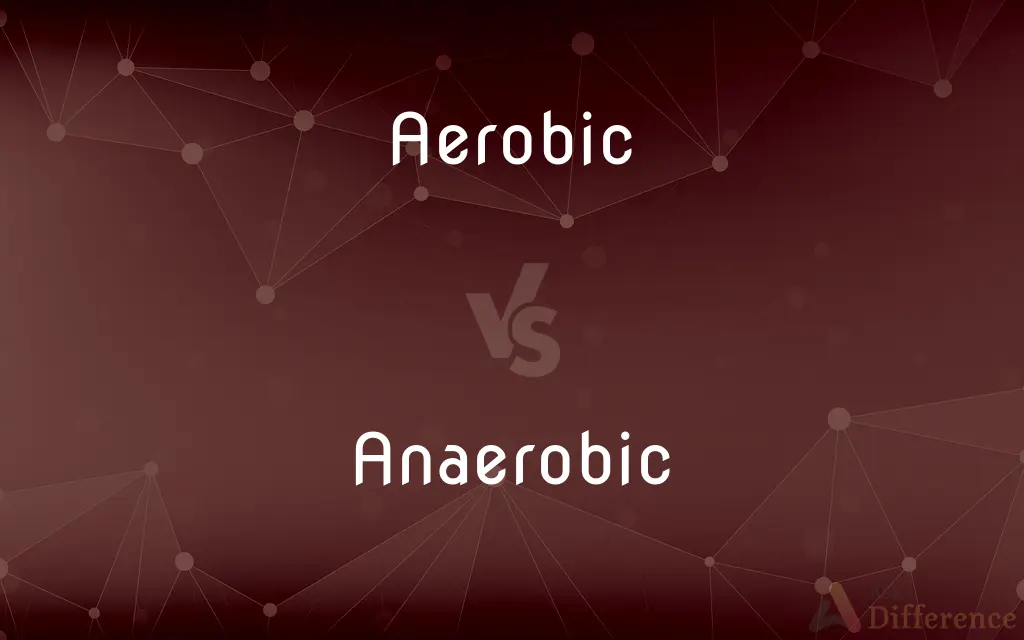Aerobic vs. Anaerobic — What's the Difference?
Edited by Tayyaba Rehman — By Fiza Rafique — Updated on November 2, 2023
Aerobic processes require oxygen, while anaerobic processes do not.

Difference Between Aerobic and Anaerobic
Table of Contents
ADVERTISEMENT
Key Differences
Aerobic activities involve the use of oxygen to meet energy demands during exercise, supporting sustained activities. In contrast, anaerobic activities do not rely on oxygen and typically support short, intense bursts of energy. While aerobic exercises like running can be maintained for longer periods, anaerobic exercises like sprinting are short-lived due to the quick depletion of energy reserves.
When considering metabolism, aerobic metabolism is more efficient, generating more energy per glucose molecule than anaerobic metabolism. However, anaerobic metabolism allows organisms to produce energy quickly and in the absence of oxygen, but it produces less energy and can lead to the accumulation of lactate.
In the environment, aerobic conditions are characterized by the presence of oxygen, facilitating the breakdown of pollutants and waste. Anaerobic conditions lack oxygen and are often found in compacted soils or deep water sediments, where different biochemical processes take place.
Aerobic bacteria require oxygen to survive and are used in processes like wastewater treatment to break down organic materials. Anaerobic bacteria, however, thrive in oxygen-free environments and are utilized in processes such as fermentation to produce alcohol or biogas.
Finally, in terms of workouts, aerobic exercise is commonly recommended for cardiovascular health and endurance building, while anaerobic exercise is key for developing muscle strength and power.
ADVERTISEMENT
Comparison Chart
Oxygen Requirement
Requires oxygen.
Does not require oxygen.
Energy Efficiency
More efficient, produces more ATP.
Less efficient, produces less ATP.
Duration of Activity
Long-duration activities.
Short-duration, high-intensity activities.
Metabolic Byproducts
Carbon dioxide and water.
Lactic acid or alcohol.
Examples
Jogging, swimming, cycling.
Sprinting, lifting heavy weights.
Compare with Definitions
Aerobic
Relating to, involving, or requiring free oxygen.
Aerobic exercises like swimming improve cardiovascular health.
Anaerobic
Occurring without the use of oxygen, as in exercise.
Sprinting is an anaerobic activity that relies on stored energy.
Aerobic
Using oxygen to meet energy demands during physical activity.
She runs marathons because her aerobic capacity is high.
Anaerobic
Involving muscular activity that causes the buildup of lactic acid.
Weight lifting is an anaerobic exercise good for building strength.
Aerobic
Involving or improving oxygen consumption by the body.
His aerobic workout routine is very effective for weight loss.
Anaerobic
Relating to, involving, or requiring an absence of free oxygen.
Anaerobic digestion is used to treat wastewater.
Aerobic
Living or occurring only in the presence of oxygen.
Aerobic bacteria were used to clean up the oil spill.
Anaerobic
Pertaining to an anaerobe.
They studied the anaerobic microorganisms from the bottom of the lake.
Aerobic
Relating to, involving, or requiring free oxygen
Simple aerobic bacteria
Anaerobic
Living or occurring in the absence of oxygen.
Anaerobic bacteria can cause diseases in humans.
Aerobic
Living or occurring only in the presence of free oxygen
Aerobic bacteria.
Anaerobic
Relating to or requiring an absence of free oxygen
Anaerobic bacteria
Aerobic
Of or relating to aerobes.
Anaerobic
Living or occurring in the absence of free oxygen
Anaerobic bacteria.
Aerobic
Involving or improving oxygen consumption by the body
Aerobic exercise.
Anaerobic
Of or relating to anaerobes.
Aerobic
Relating to or used in aerobics
Aerobic shoes.
Anaerobic
Without oxygen; especially of an environment or organism.
Aerobic
Living or occurring only in the presence of oxygen e.g. aerobic bacteria.
Anaerobic
Of exercise, involving glycolysis (the conversion of glucose to adenosine triphosphate) rather than using oxygen to supply bodily energy needs.
Aerobic
Of exercise, performed while maintaining a sufficient supply of oxygen to meet bodily energy needs.
Anaerobic
Of or relating to an anaerobe.
Aerobic
Of or relating to aerobics.
Anaerobic
Not requiring air or oxygen for life; - applied especially to those microbes to which free oxygen is unnecessary; anaërobiotic; - opposed to aërobic.
Aerobic
Growing or thriving only in the presence of oxygen; also, pertaining to, or induced by, aërobies; as, aërobic fermentation.
Anaerobic
Relating to, or like, anaërobies; anaërobiotic.
Aerobic
Depending on free oxygen or air;
Aerobic fermentation
Anaerobic
Living or active in the absence of free oxygen;
Anaerobic bacteria
Aerobic
Based on or using the principles of aerobics; enhancing respiratory and circulatory efficiency;
Aerobic dance
Running is very aerobic
Anaerobic
Not aerobic;
Isometric exercises are anaerobic
Aerobic
Pertaining to aerobes.
The soil in the garden is teeming with aerobic organisms.
Common Curiosities
Are anaerobic processes less efficient than aerobic?
Yes, anaerobic processes are less efficient at producing energy than aerobic processes.
What types of sports are considered anaerobic?
Sports that involve quick bursts of energy, like weightlifting and sprinting, are considered anaerobic.
Is aerobic or anaerobic exercise better for the heart?
Both can benefit the heart in different ways; aerobic exercises improve endurance while anaerobic improves overall strength.
What happens to muscles during anaerobic exercise?
Muscles use stored energy sources and can build up lactic acid during anaerobic exercise.
What defines an aerobic exercise?
An aerobic exercise is one that increases the heart rate and uses oxygen to burn fats and glucose for energy.
Can anaerobic exercise improve aerobic capacity?
Yes, anaerobic exercise can improve overall fitness, which can enhance aerobic capacity.
Can only aerobic exercise improve lung capacity?
Aerobic exercise is especially good for increasing lung capacity, but anaerobic exercise also has benefits.
What is anaerobic threshold?
The anaerobic threshold is the point during intense exercise at which the body starts to produce lactic acid.
Why is oxygen important for aerobic processes?
Oxygen is essential for the aerobic process because it is the final electron acceptor in the electron transport chain, which produces ATP.
Can aerobic workouts help with weight loss?
Yes, aerobic workouts can help burn calories and fat, aiding in weight loss.
Are anaerobic workouts shorter than aerobic ones?
Typically, yes, because anaerobic workouts are intense and cannot be sustained for as long as aerobic workouts.
Can I do aerobic and anaerobic exercises in the same workout?
Yes, many training regimens combine both types of exercise for a balanced workout.
How does anaerobic exercise affect muscle growth?
Anaerobic exercise stimulates muscle growth and increases muscle strength.
Is it possible to perform anaerobic exercise at home?
Yes, exercises like push-ups and sit-ups can be done at home and are considered anaerobic.
Do aerobic activities always need to be of low intensity?
No, aerobic activities can vary in intensity as long as they can be sustained with oxygen.
Share Your Discovery

Previous Comparison
Titanium vs. Titan
Next Comparison
Gangway vs. BrowAuthor Spotlight
Written by
Fiza RafiqueFiza Rafique is a skilled content writer at AskDifference.com, where she meticulously refines and enhances written pieces. Drawing from her vast editorial expertise, Fiza ensures clarity, accuracy, and precision in every article. Passionate about language, she continually seeks to elevate the quality of content for readers worldwide.
Edited by
Tayyaba RehmanTayyaba Rehman is a distinguished writer, currently serving as a primary contributor to askdifference.com. As a researcher in semantics and etymology, Tayyaba's passion for the complexity of languages and their distinctions has found a perfect home on the platform. Tayyaba delves into the intricacies of language, distinguishing between commonly confused words and phrases, thereby providing clarity for readers worldwide.















































